Loving the Open Championship means loving links golf. There’s something so refreshing about watching players hit shots we don’t usually see, in weather we’d usually try to avoid. To play links golf well, there are a few shots you need to be able to hit. On a trip to Scotland, Jason Guss, a Golf Digest Best Young Teacher in Illinois, took the time to catalog the three shots every golfer should learn if they want to be effective on links courses. While watching the Open Championship at Royal Portrush this week, you’ll see these shots in action.
The High Bunker Shot
Links courses feature deep bunkers. So deep, you’ll be tempted to play the ball away from the hole, just to get out of them. If you know how to hit a high-lofted bunker shot, you can keep the ball moving towards the hole.
“If you can save yourself a couple times a round from having to go backwards, that’s a big deal,” Guss says. “Sometimes, once you’re in greenside bunkers, you have to go backwards or sideways. And then you’re pitching back over the bunker. You’re not trying to get up and down, you’re trying to get up on the green.”
To hit this shot, Guss says to open the face and get the majority of your weight on your front foot.
“Feel like you have a lower finish going through so the club gets into the sand,” Guss says. “You need speed for this shot. You have to trust that you can swing it really fast. When people tend to swing fast, they pull out of it. Have speed and stay down and through.”
Another common error Guss sees amateurs make with this shot is that they tend to tilt their upper body back, away from the target, in an effort to help lift the ball up. The result: They blade the shot into the face of the bunker. Guss says you don’t need to help the ball up. You’ve already opened the face, and that’s all the loft the shot needs.
The Bump and Run 
Around the greens, out of the bunkers, you’ll find firm, undulating turf on links courses. Put your sand wedge away, and grab and iron instead.
“There’s no forgiveness because there’s so little grass,” Guss says. “You need to be able to bump it into the hills and keep it low on the ground. You’re trying to avoid the disaster shot, and hitting 60 off a tight lie could lead to a disaster. The bump and run is an easier shot for most people; they just don’t know it yet.”
To hit a bump and run, take an iron, anywhere from your 7 iron to your pitching wedge.
“Play the ball in the middle of your stance,” Guss says. “Get your nose and sternum in front of the ball at address. You want 90% of your weight on the front foot. Tilt your shoulders so that the lead is lower than the trailing. That helps the club come up a bit in the back and help you strike down on it slightly.”
Use a small, putting-like stroke and watch the ball pop off the face and run out.
“Remember, if you’re not used to hitting an 8 or 7 iron, the ball is gonna come off hotter,” Guss says. “It depends on the shot and the club, but generally you’ll want to fly it about 30% of the way to the hole and let it run out the rest of the way.”
The Knockdown
When the wind is whipping on a links course, you want to keep your approach shots low. The easiest way to do that is to hit a knockdown.
“Take one to two more clubs than you need and play the ball middle to slightly back in your stance,” Guss says. “Your weight should be more forward at setup. Feel it stay forward on the takeaway. When you swing through, abbreviate your through swing.”
One of the keys to taking more club is that it’ll help you swing a little easier, Guss says. Keeping your speed down will also help you flight the ball lower.
“If you have enough club, your through swing will be shorter, which will lower trajectory,” Guss says.
After teaching students the knockdown, Guss has noticed that it can improve their contact so much that they adopt more of a knockdown swing in general.
“You may find your knockdown becomes your normal iron swing after doing this,” Guss says.
This article was originally published on golfdigest.com




